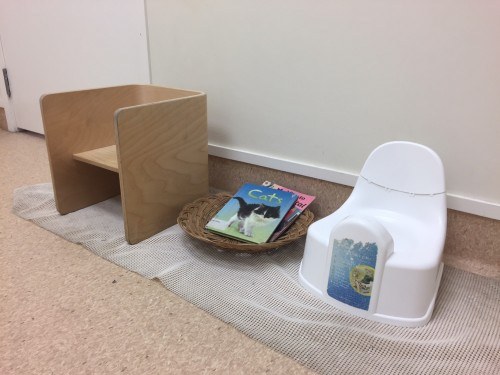 5 Nov 2018
5 Nov 2018Independence is so often overlooked for toddlers. In fact, once children have full control over their bodies and they can toilet themselves, they naturally want to be more independent.
Toileting, for children, is a rite of passage – it is part of the transition from high dependency to independency. Signs of readiness include that the child can stay dryer for longer, they can tell someone they need to go, they can remove their own pants, they may even seek privacy or show an interest with others going to the toilet – and other such signs.
When we observe an interest in toileting, it is time to act! By not delaying until three, you can introduce a fairly young child, even as young as 18m – two, to using a toilet with very little problem. Three year olds often say “no” a lot, so if they express the interest, the earlier, the better in many ways!
In true Montessori fashion at our centre, we utilise a “prepared environment” in our bathroom that is set up the same every day for children to utilize: a solid chair, some books and a potty, all on a wee mat (pun intended)! Children are asked to wear two-piece clothing with an elastic waist that they can easily pull down themselves. Their undies may initially be worn inside the nappy so that consequences of wetting are felt and thereby learnt.
Initially, we give the child an opportunity to sit for a while on the chair with no nappy, to read a book. After a while, we offer the child the opportunity to sit on a tall-backed potty. Eventually, the child will make their own water, and eventually they will want to use the real toilet – it can be quite fun to flush it!
The adult’s attitude can make a big difference for the child. Rather than being adult driven, toilet learning is when children are actively involved in their own learning. Genuine praise is important, as toilet learning is also linked to self-esteem. During the learning process, it is likely that the child will urinate, and as opposed to being considered “accidents”, they are dealt with calmly as learnings. “Oh dear, you wet yourself” – fact. Real language, using correct terms, and always a calm voice.
It is recommended that boys sit instead of stand until they have mastered how to produce solid waste on the toilet, and by that stage they will better understand which feeling does what. As bowel motions are often predictable, a chart of times may be useful to establish a pattern.
A good pre-school / centre will always work with the family at home and so good communication is vital. And of course an internet search on “toilet learning” will provide you with lots of different articles and inspiration!
Fountain City Montessori can help with client toilet learning, however we currently only have vacancies for babies and under two and a half year olds – which happens to be perfect timing! Visitors are welcome.

